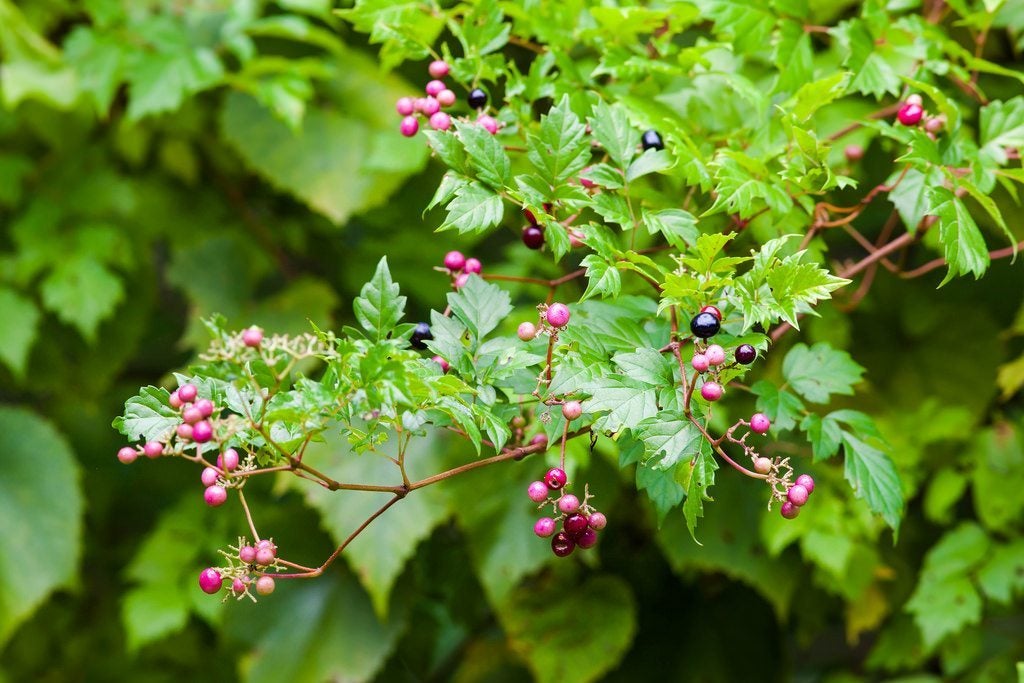Peppervine Control: Tips On Managing Peppervines In The Garden
Due to its vigorous root system, once peppervine takes hold, it will overtake a garden and choke out other plants in its path. Learn about controlling it.


Colorful berries. Hardy. Good ground cover. Climbs trellises. Pest resistant. Oooh! Wait - don’t get too excited. These desirable characteristics belong to what many consider to be an undesirable plant. I am talking about peppervine.
What is peppervine, you ask? Peppervine (Ampelopsis arborea) is a perennial climbing vine native to the lower 48 states and Puerto Rico. To some it may be known as “buckvine” and “cow itch” but to others it may be known as an expletive because it's very invasive due to its vigorous root system. Once it takes hold, it will overtake a garden and choke out plants in its path. Read on to learn more about peppervine control.
What is Peppervine?
Peppervine is a close cousin of grapes. It is a vigorous invasive plant which can climb heights up to 20 feet (6 m) tall.
This woody stemmed plant produces greenish white flowers during the summer months and is loaded with berries in the fall. Its leaves emerge with a reddish hue and turn dark green at maturity. Berries on a cluster also go through a spectrum of four colors as they mature, starting with green, then white, red, and lastly blue-black.
Given that the berries mature at different rates, the berry clusters can be quite colorful. Birds and mammals contribute to the spread of this plant by consuming the berries and dispersing the seed in their droppings.
How to Get Rid of Peppervine
If you are asking how to get rid of peppervine in the garden, you do have options. Do keep in mind that these options for controlling peppervine plants require due diligence and persistence.
When managing peppervines, you need to continually monitor and treat an affected area over a period of a few years to ensure that you have eradicated the peppervine plant and hindered a possible comeback.
Gardening tips, videos, info and more delivered right to your inbox!
Sign up for the Gardening Know How newsletter today and receive a free copy of our e-book "How to Grow Delicious Tomatoes".
If your peppervine encompasses just a small area, your best recourse is good old-fashioned hand pulling in the spring before the plant flowers and produces seed. When hand pulling, this method of peppervine control is most effective if you can remove as much of the plant’s tap root as possible. However, older more developed plants may have tap roots so deep that they won’t budge. Not a problem! You can meet the resistance by cutting the plant stalk near the ground and treating the cut stem with a broadleaf herbicide. Sometimes, however, hand-pulling just isn’t practical due to the size of the area impacted or gardener limitations. In this case, chemical control may be your only resort for managing peppervines. There are a number of different chemicals that can be utilized for controlling peppervine plants, many with names that are a mouthful! To suppress emerging seedlings, you may want to consider using an organic pre-emergent herbicide.
To decimate the actively growing weeds. When handling and applying products, be sure to always follow all safety protocols and directions for application. For eradication methods that are not harmful to the environment, consult with your local extension agency.
Note: Chemical control should only be used as a last resort, as organic approaches are safer and much more environmentally friendly.

Shelley Pierce was a writer for Gardening Know How, contributing to hundreds of articles for the site.
-
 Moody Blooms For Spring: 8 Types Of Black Flowers To Add Drama To Spring Displays
Moody Blooms For Spring: 8 Types Of Black Flowers To Add Drama To Spring DisplaysFrom midnight burgundies to inky violets, several types of black flowers can enrich and embolden a spring display. Try these brooding bloomers for a moody garden
By Tonya Barnett
-
 Can Snake Plants Live Outside? Everything You Need To Know For Snake Plants Al Fresco
Can Snake Plants Live Outside? Everything You Need To Know For Snake Plants Al FrescoSnake plants can live outside given the right conditions, but be careful that they don't take over! Learn the best way to use snake plants in your landscape.
By Mary Ellen Ellis